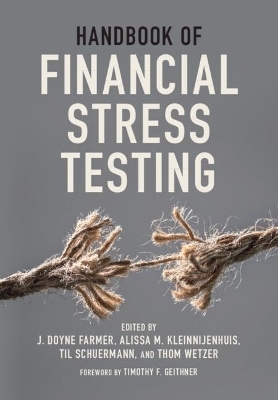
Handbook of Financial Stress Testing
Cambridge University Press (Verlag)
978-1-108-83073-7 (ISBN)
Stress tests are the most innovative regulatory tool to prevent and fight financial crises. Their use has fundamentally changed the modeling of financial systems, financial risk management in the public and private sector, and the policies designed to prevent and mitigate financial crises. When financial crises hit, stress tests take center stage. Despite their centrality to public policy, the optimal design and use of stress tests remains highly contested. Written by an international team of leading thinkers from academia, the public sector, and the private sector, this handbook comprehensively surveys and evaluates the state of play and charts the innovations that will determine the path ahead. It is a comprehensive and interdisciplinary resource that bridges theory and practice and places financial stress testing in its wider context. This guide is essential reading for researchers, practitioners, and policymakers working on financial risk management and financial regulation.
J. Doyne Farmer is Director of Complexity Economics at the Institute for New Economic Thinking at the Oxford Martin School, and is the Baillie Gifford Professor at Mathematical Institute at the University of Oxford, as well as an External Professor at the Santa Fe Institute. His current research is in economics, including financial stability, sustainability, technological change and economic simulation. He was a founder of Prediction Company, a quantitative automated trading firm that was sold to the United Bank of Switzerland in 2006. His past research spans complex systems, dynamical systems, time series analysis and theoretical biology. He founded the Complex Systems Group at Los Alamos National Laboratory, and while a graduate student in the 1970s he built the first wearable digital computer, which was successfully used to predict the game of roulette. Alissa M. Kleinnijenhuis is a Research Scholar at the Stanford Institute for Economic Policy Research (SIEPR), at Stanford University. She is also a Senior Research Fellow at the Institute for New Economic Thinking at the Oxford Martin School at the University of Oxford. Her focal areas of research are financial crises and climate finance, linked by their emphasis on addressing externalities emerging from too-big-to-fail (or too-many-to-fail) financial institutions and climate change. Subtopics of special relevance in her studies are financial regulation, models of contagion and systemic risk, financial stress testing, financial intermediation, monetary policy, asset pricing, and climate financial risks and opportunities. Her recent work has shed light on the system-wide implications of key pillars of the post-crisis regulatory reform. She has also developed novel tools, including system-wide stress tests, to measure systemic risk and evaluate policies. Kleinnijenhuis collaborates with both policymakers and practitioners, including researchers at the Bank of England, the European Central Bank, the International Monetary Fund and Fidelity Investments. Til Schuermann is a partner at Oliver Wyman where he advises private and public sector clients on stress testing, capital planning, enterprise-wide risk management, model risk management, climate risk and governance including board effectiveness. He serves on several advisory and editorial boards and is an associate editor of the Journal of Financial Services Research and the Journal of Risk. He played a leadership role in the design and execution of the 2009 US bank stress test and advised the banking system stress tests for Spain (2012), Slovenia (2013) and the ECB's 2014 Europe-wide stress test. Thom Wetzer is Associate Professor of Law and Finance at the University of Oxford, Founding Director of the Oxford Sustainable Law Programme and Senior Research Fellow at the Institute for New Economic Thinking at the Oxford Martin School. His research examines how law and finance can generate value and advance the public good with a particular focus on financial regulation, corporate governance, financial risk management and climate risk. Wetzer actively collaborates with policymakers and practitioners, including at the Bank of England, the European Central Bank, the International Monetary Fund and De Brauw Blackstone Westbroek.
Foreword Timothy F. Geithner; 1. Introduction and overview J. Doyne Farmer, Alissa M. Kleinnijenhuis, Til Schuermann and Thom Wetzer; Part I. History and Objectives: 2. Objectives and challenges of stress testing Richard J. Herring and Til Schuermann; 3. Fit for purpose? The evolving role of stress testing for financial systems Udaibir Das, Kieran Dent and Miguel Segoviano; 4. Why banks failed the stress test: A progress report on stress testing ten years on Nicola Anderson, Alex Brazier, Andrew Haldane, Paul Nahai-Williamson and Amar Radia; Part II. Inputs and Outputs: 5. Macrofinancial stress test scenario design – for banks and beyond Marco Gross, Jérôme Henry and Elena Rancoita; 6. The role of heterogeneity in scenario design for financial stability stress testing Mark D. Flood, Jonathan Jones, Matthew Pritsker and Akhtar Siddique; 7. Designing coherent scenarios: a practitioner perspective Greg Hopper; 8. Stress testing with market data Robert Engle; 9. On market-based approaches to the valuation of capital Natasha Sarin and Lawrence H. Summers; 10. Granular data offer new opportunities for stress testing Cees Ullersma and Iman van Lelyveld; 11. Stress tests disclosure: theory, practice, and new perspectives Itay Goldstein and Yaron Leitner; 12. Stress testing during times of war Kathryn Judge; Part III. Microprudential Stress Tests: 13. Stress testing for commercial, investment and custody banks Daniel Cope, Carey Hsu, Clinton Lively, James Morgan, Til Schuermann and Evan Sekeris; 14. Microprudential stress testing for asset managers Jacques Longerstaey; 15. Stress testing for insurers Brian Peters; 16. Model risk management in stress testing and capital planning Eduardo Canabarro; 17. A supervisory perspective on stress testing – The U.S. experience Tim P. Clark; 18. Strengths and weaknesses of microprudential stress testing for financial institutions Christine M. Cumming; Part IV. A Macroprudential Perspective on the Financial System: 19. The structure of the financial system: Implications for macro-prudential stress testing Gonzalo Fernandez Dionis and Patricia C. Mosser; 20. Holistic bank regulation C. A. E. Goodhart; 21. Leverage and macro prudential policy John Geanakoplos; 22. Monetary policy and financial stability William B. English; 23. Stress testing networks: The case of central counterparties Richard B. Berner, Stephen G. Cecchetti and Kermit L. Schoenholtz; Part V. Macroprudential Stress Tests: 24. Enhancing stress tests by adding macroprudential elements William F. Bassett and David E. Rappoport W.; 25. Accounting for amplification mechanisms in bank stress test models at the Bank of Canada Grzegorz Halaj and Virginie Traclet; 26. Stress testing at the IMF Tobias Adrian, James Morsink and Liliana Schumacher; 27. A comprehensive approach to macroprudential stress testing Anthony Bousquet, Jérôme Henry and Dawid Żochowski; 28. A complex systems perspective on macroprudential regulation Stefan Thurner; 29. Stress testing a central bank's own balance sheet Nathanaël Benjamin, Abigail Haddow and David Jacobs; Part VI. Concluding Thoughts: The Road Ahead: 30. Stress testing the financial microcosm J. Doyne Farmer, Alissa M. Kleinnijenhuis and Thom Wetzer.
| Erscheinungsdatum | 14.04.2022 |
|---|---|
| Zusatzinfo | Worked examples or Exercises |
| Verlagsort | Cambridge |
| Sprache | englisch |
| Maße | 182 x 260 mm |
| Gewicht | 1610 g |
| Themenwelt | Mathematik / Informatik ► Mathematik ► Angewandte Mathematik |
| Wirtschaft ► Betriebswirtschaft / Management ► Finanzierung | |
| ISBN-10 | 1-108-83073-0 / 1108830730 |
| ISBN-13 | 978-1-108-83073-7 / 9781108830737 |
| Zustand | Neuware |
| Informationen gemäß Produktsicherheitsverordnung (GPSR) | |
| Haben Sie eine Frage zum Produkt? |
aus dem Bereich


